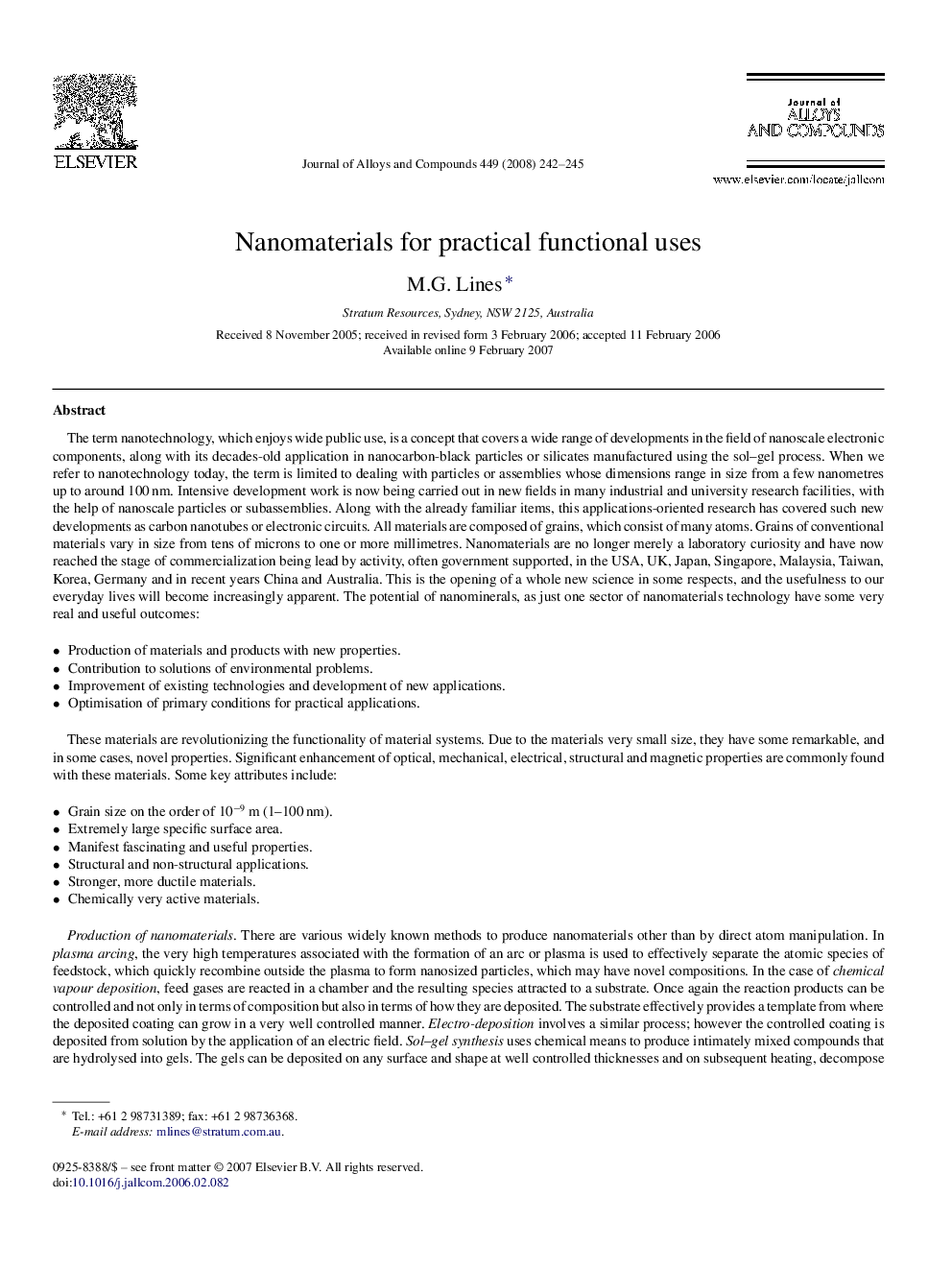| کد مقاله | کد نشریه | سال انتشار | مقاله انگلیسی | نسخه تمام متن |
|---|---|---|---|---|
| 1625474 | 1516427 | 2008 | 4 صفحه PDF | دانلود رایگان |

The term nanotechnology, which enjoys wide public use, is a concept that covers a wide range of developments in the field of nanoscale electronic components, along with its decades-old application in nanocarbon-black particles or silicates manufactured using the sol–gel process. When we refer to nanotechnology today, the term is limited to dealing with particles or assemblies whose dimensions range in size from a few nanometres up to around 100 nm. Intensive development work is now being carried out in new fields in many industrial and university research facilities, with the help of nanoscale particles or subassemblies. Along with the already familiar items, this applications-oriented research has covered such new developments as carbon nanotubes or electronic circuits. All materials are composed of grains, which consist of many atoms. Grains of conventional materials vary in size from tens of microns to one or more millimetres. Nanomaterials are no longer merely a laboratory curiosity and have now reached the stage of commercialization being lead by activity, often government supported, in the USA, UK, Japan, Singapore, Malaysia, Taiwan, Korea, Germany and in recent years China and Australia. This is the opening of a whole new science in some respects, and the usefulness to our everyday lives will become increasingly apparent. The potential of nanominerals, as just one sector of nanomaterials technology have some very real and useful outcomes:
• Production of materials and products with new properties.
• Contribution to solutions of environmental problems.
• Improvement of existing technologies and development of new applications.
• Optimisation of primary conditions for practical applications.These materials are revolutionizing the functionality of material systems. Due to the materials very small size, they have some remarkable, and in some cases, novel properties. Significant enhancement of optical, mechanical, electrical, structural and magnetic properties are commonly found with these materials. Some key attributes include:
• Grain size on the order of 10−9 m (1–100 nm).
• Extremely large specific surface area.
• Manifest fascinating and useful properties.
• Structural and non-structural applications.
• Stronger, more ductile materials.
• Chemically very active materials.Production of nanomaterials. There are various widely known methods to produce nanomaterials other than by direct atom manipulation. In plasma arcing, the very high temperatures associated with the formation of an arc or plasma is used to effectively separate the atomic species of feedstock, which quickly recombine outside the plasma to form nanosized particles, which may have novel compositions. In the case of chemical vapour deposition, feed gases are reacted in a chamber and the resulting species attracted to a substrate. Once again the reaction products can be controlled and not only in terms of composition but also in terms of how they are deposited. The substrate effectively provides a template from where the deposited coating can grow in a very well controlled manner. Electro-deposition involves a similar process; however the controlled coating is deposited from solution by the application of an electric field. Sol–gel synthesis uses chemical means to produce intimately mixed compounds that are hydrolysed into gels. The gels can be deposited on any surface and shape at well controlled thicknesses and on subsequent heating, decompose to leave a thin layer of the desired coating. This technique is well suited to coating large surface areas with very well defined nanometre scale compounds. In high intensity ball milling, as the name suggested, high impact collisions are used to reduce macrocrystalline materials down into nano-crystalline structures without chemical change. A relatively new technique termed Mechanochemical Processing (MCP) technology, being developed by Advanced Nanotechnologies based in Perth, is a novel, solid-state process for the manufacture of a wide range of nanopowders. Dry milling is used to induce chemical reactions through ball-powder collisions that result in nanoparticles formed within a salt matrix. Particle size is defined by the chemistry of the reactant mix, milling and heat treatment conditions. Particle agglomeration is minimized by the salt matrix, which is then removed by a simple washing procedure.
Journal: Journal of Alloys and Compounds - Volume 449, Issues 1–2, 31 January 2008, Pages 242–245